|
|
|||||||
|
HOME
|
US Navy -
ships
|
US Navy - air
units
|
USMC - air
units
|
International
Navies
|
Weapon Systems
|
Special Reports |
|||||||
|
|
|||||||
|
|
|||||||
US Marine Corps - Marine Medium Tiltrotor Squadron 365VMM-365 'Blue Knights' |
|||||||
|
|
|||||||
 |
 |
||||||
|
|
|||||||
|
|||||||
|
|
|||||||
images |
|||||||
 MV-22B Osprey (VMM-365) aboard USS Bataan (LHD 5) - January 2017  MV-22B Osprey (VMM-365) aboard USS Bataan (LHD 5) - January 2017  MV-22B Osprey (VMM-365) aboard USS Bataan (LHD 5) - January 2017  MV-22B Osprey (VMM-365) aboard USS Bataan (LHD 5) - January 2017  MV-22B Osprey (VMM-365) aboard USS Carter Hall (LSD 50) - December 2016  MV-22B Osprey (VMM-365) aboard USS Carter Hall (LSD 50) - December 2016  MV-22B Osprey (VMM-365) during inflight refueling - November 2016  MV-22B Osprey (VMM-365) during inflight refueling - November 2016  MV-22B Osprey (VMM-365) - November 2016  MV-22B Osprey (VMM-365) at MCAS New River, North Carolina - November 2016  MV-22B Osprey (VMM-365) at Camp Lejeune, North Carolina - November 2016  MV-22B Osprey (VMM-365) aboard USS Iwo Jima (LHD 7) - October 2016 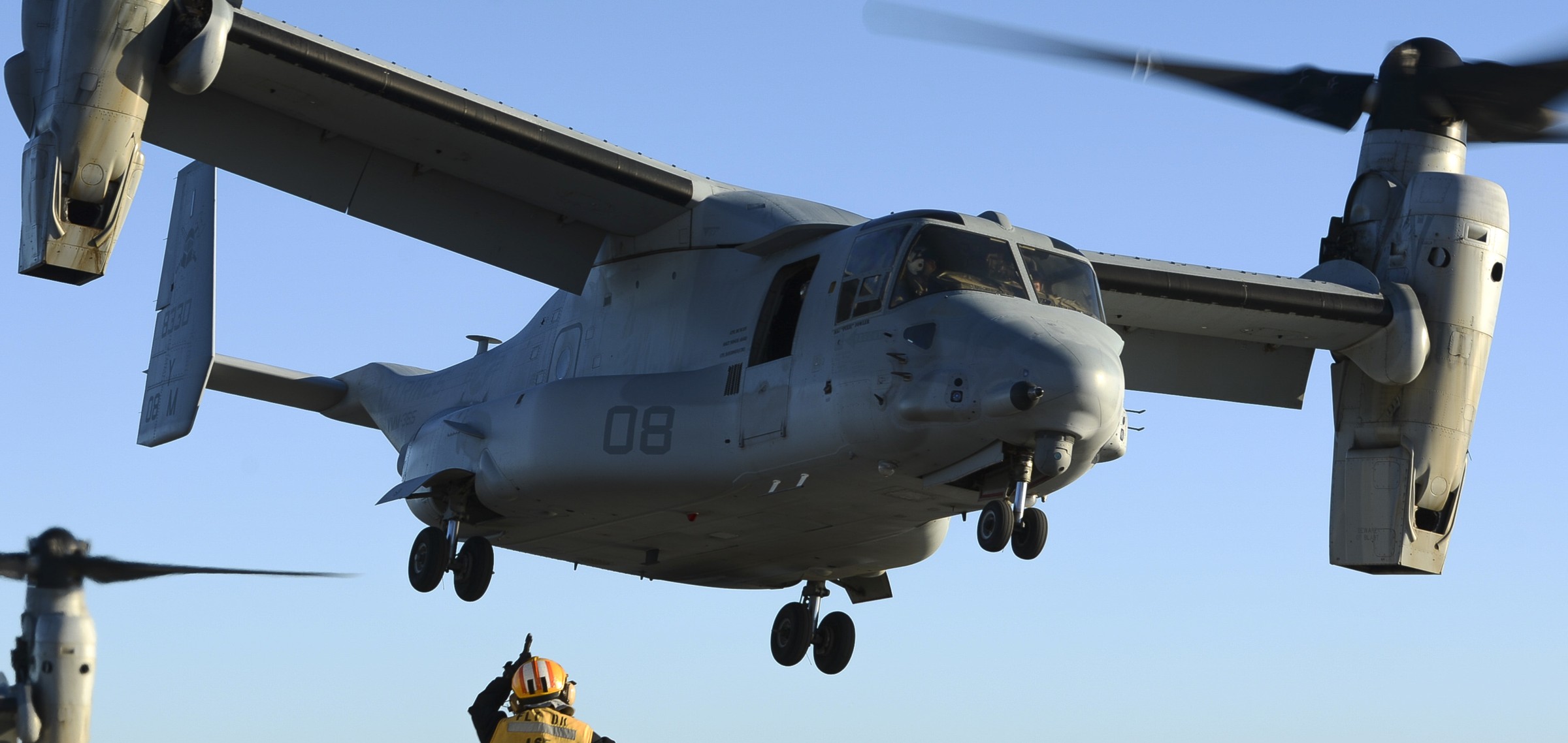 MV-22B Osprey (VMM-365) aboard USS Iwo Jima (LHD 7) - October 2016  MV-22B Osprey (VMM-365) aboard USS Iwo Jima (LHD 7) - October 2016  MV-22B Osprey (VMM-365) aboard USS Iwo Jima (LHD 7) - October 2016  MV-22B Osprey (VMM-365) aboard USS Iwo Jima (LHD 7) - October 2016  MV-22B Osprey (VMM-365) - Haiti - October 2016  MV-22B Osprey (VMM-365) - Haiti - October 2016  MV-22B Osprey (VMM-365) aboard USS George Washington (CVN 73) - October 2016 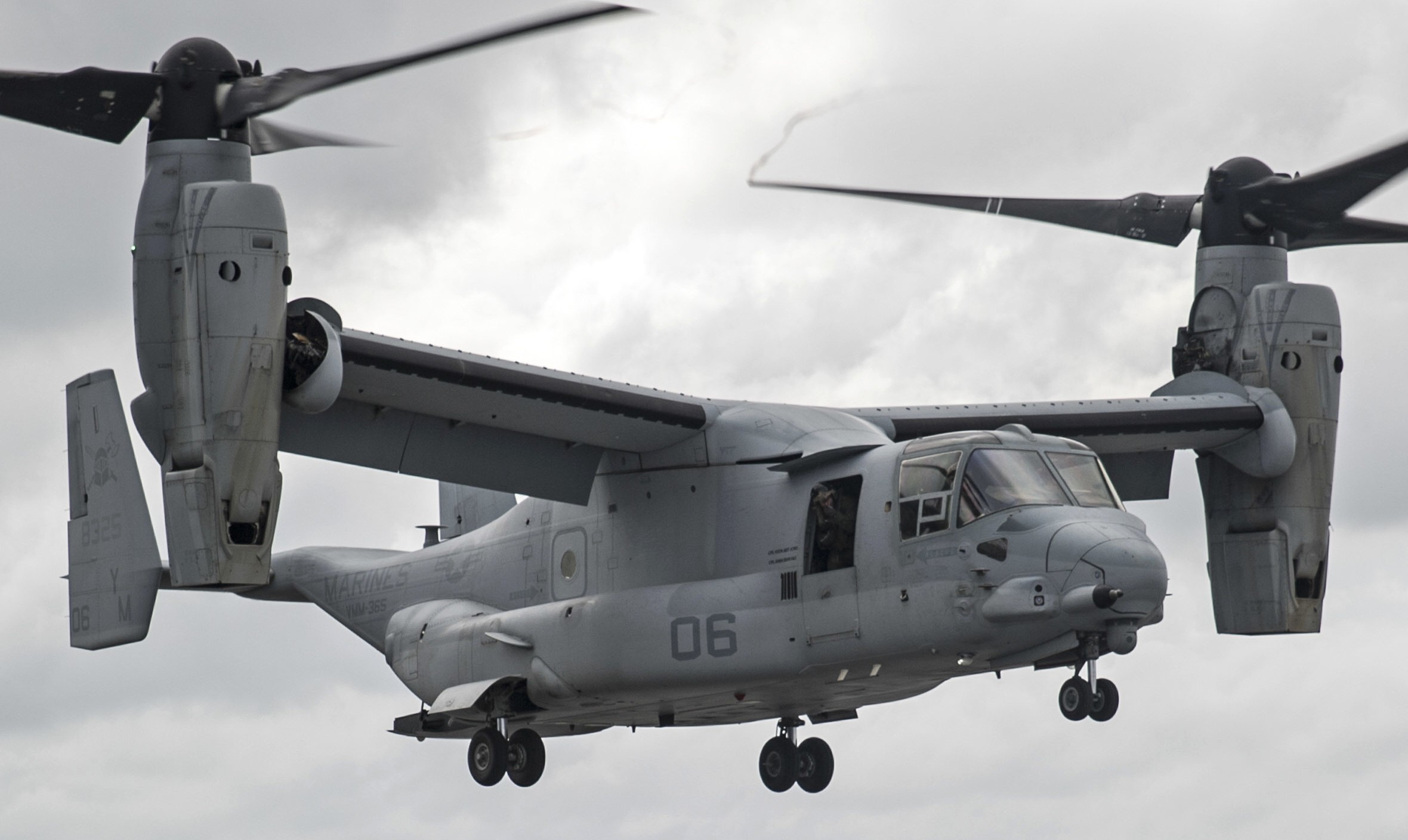 MV-22B Osprey (VMM-365) aboard USS George Washington (CVN 73) - October 2016  MV-22B Osprey (VMM-365) aboard USS George Washington (CVN 73) - October 2016  MV-22B Osprey (VMM-365) aboard USS George Washington (CVN 73) - October 2016 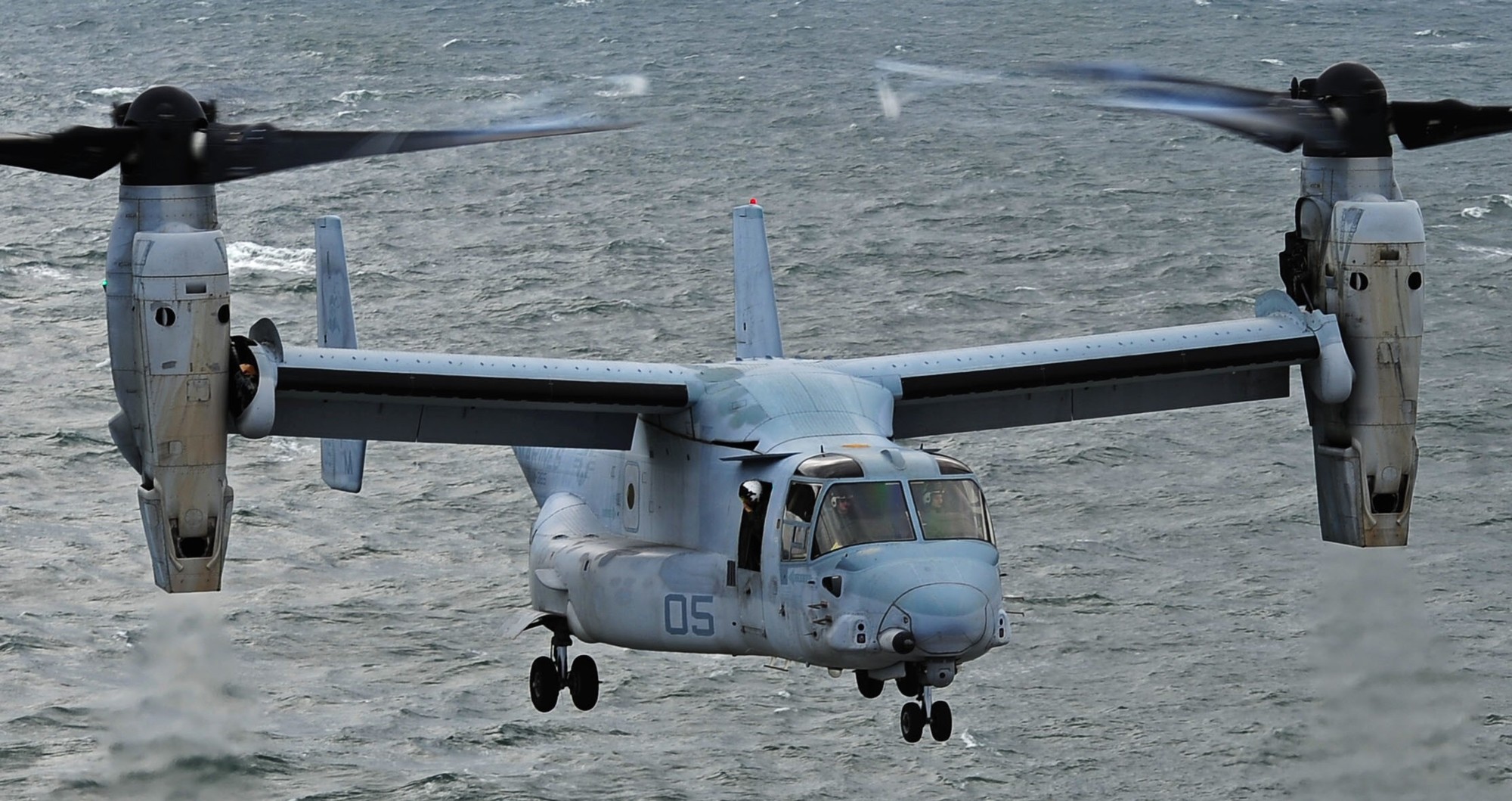 MV-22B Osprey (VMM-365) aboard USS George Washington (CVN 73) - October 2016  MV-22B Osprey (VMM-365) aboard USS George Washington (CVN 73) - October 2016  MV-22B Osprey (VMM-365) aboard USS Bataan (LHD 5) - September 2016  MV-22B Osprey (VMM-365) aboard USS Bataan (LHD 5) - September 2016  MV-22B Osprey (VMM-365) at Camp Lejeune, North Carolina - March 2016  MV-22B Osprey (VMM-365) at Camp Lejeune, North Carolina - March 2016  MV-22B Osprey (VMM-365) at Camp Lejeune, North Carolina - March 2016  MV-22B Osprey (VMM-365) at MCAS New River, North Carolina - February 2016  MV-22B Osprey (VMM-365) at MCAS New River, North Carolina - February 2016  MV-22B Osprey (VMM-365) tail gunner live fire exercise - February 2016  MV-22B Osprey (VMM-365) at MCAS New River, North Carolina - January 2016  MV-22B Osprey (VMM-365) at MCAS New River, North Carolina - January 2016  MV-22B Osprey (VMM-365) aboard USS Dwight D. Eisenhower (CVN 69) - December 2015  MV-22B Osprey (VMM-365) aboard USS Dwight D. Eisenhower (CVN 69) - December 2015  MV-22B Osprey (VMM-365) - September 2015  MV-22B Osprey (VMM-365) - September 2015  MV-22B Osprey (VMM-365) near MCB Camp Lejeune - August 2015  MV-22B Osprey (VMM-365) near MCB Camp Lejeune - August 2015  MV-22B Osprey (VMM-365) at MCB Camp Lejeune - August 2015  MV-22B Osprey (VMM-365) at MCB Camp Lejeune - August 2015  MV-22B Osprey (VMM-365) at MCB Camp Lejeune - August 2015  MV-22B Osprey (VMM-365) at MCB Camp Lejeune - August 2015  MV-22B Osprey (VMM-365) aboard USS Iwo Jima (LHD 7) - May 2015 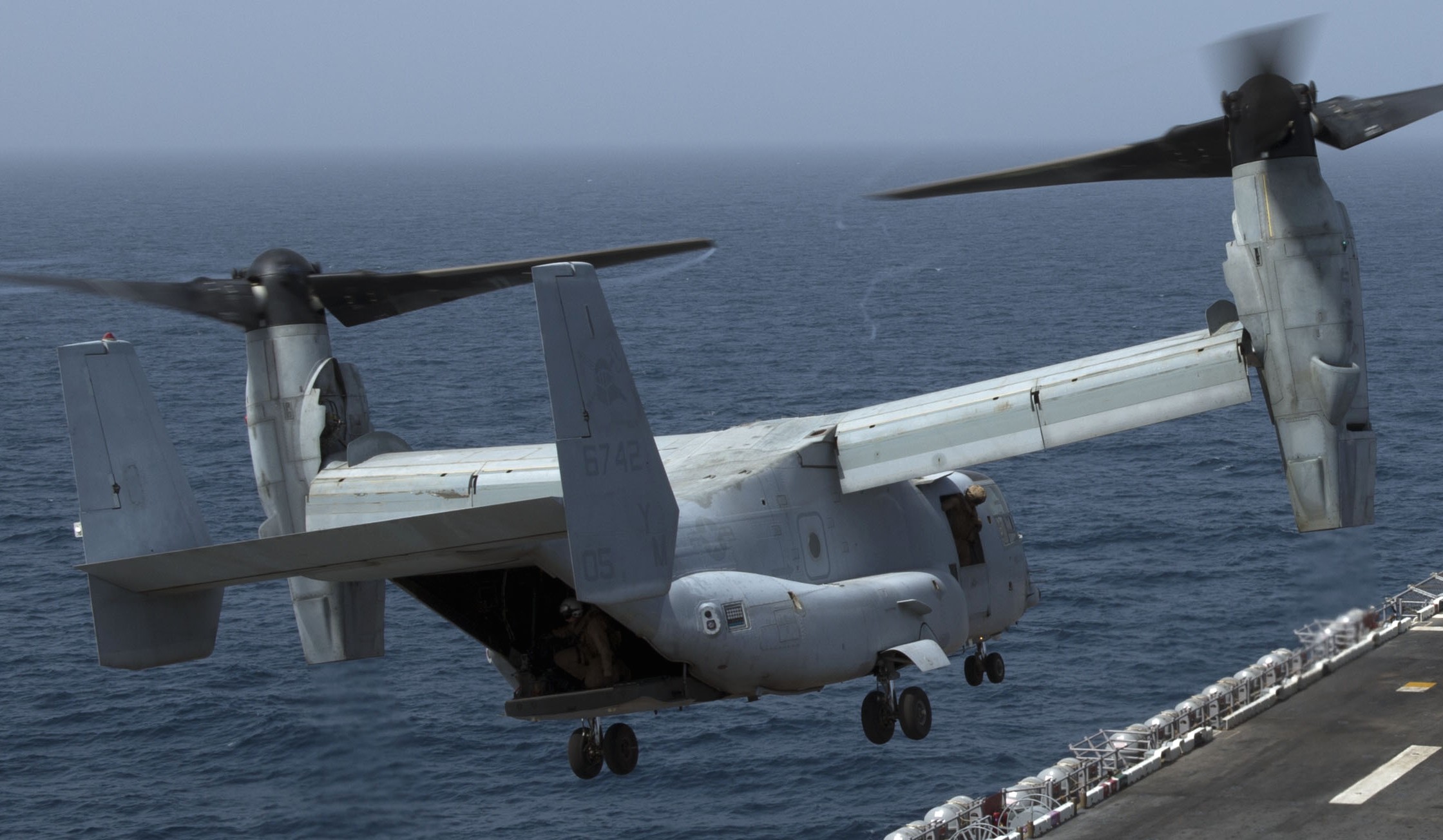 MV-22B Osprey (VMM-365) aboard USS Iwo Jima (LHD 7) - March 2015  MV-22B Osprey (VMM-365) aboard USS New York (LPD 21) - March 2015  MV-22B Osprey (VMM-365) aboard USS New York (LPD 21) - January 2015  MV-22B Osprey (VMM-365) aboard USS New York (LPD 21) - January 2015  MV-22B Osprey (VMM-365) aboard USS Iwo Jima (LHD 7) - December 2014  MV-22B Osprey (VMM-365) at Camp Lejeune, North Carolina - October 2014 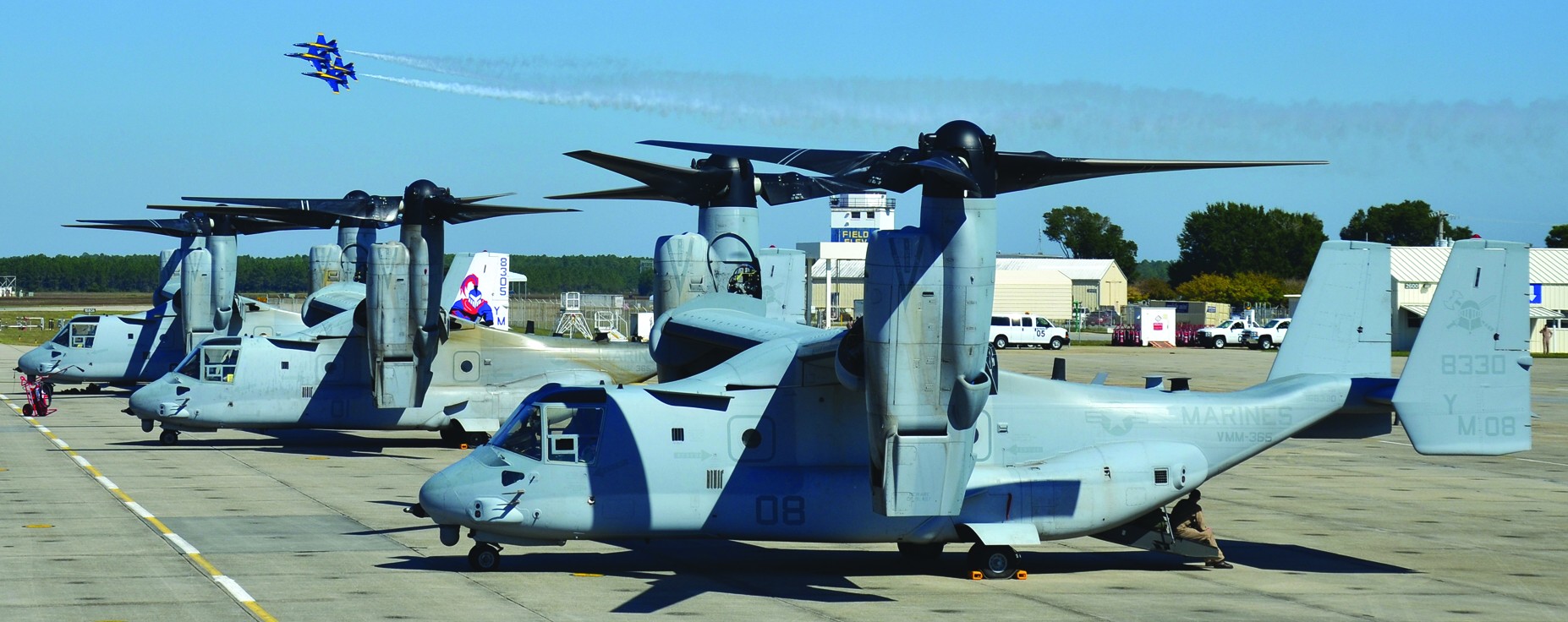 MV-22B Osprey (VMM-365) at NAS Pensacola, Florida - October 2014  MV-22B Osprey (VMM-365) aboard USS Iwo Jima (LHD 7) - October 2014  MV-22B Osprey (VMM-365) aboard USS Iwo Jima (LHD 7) - October 2014 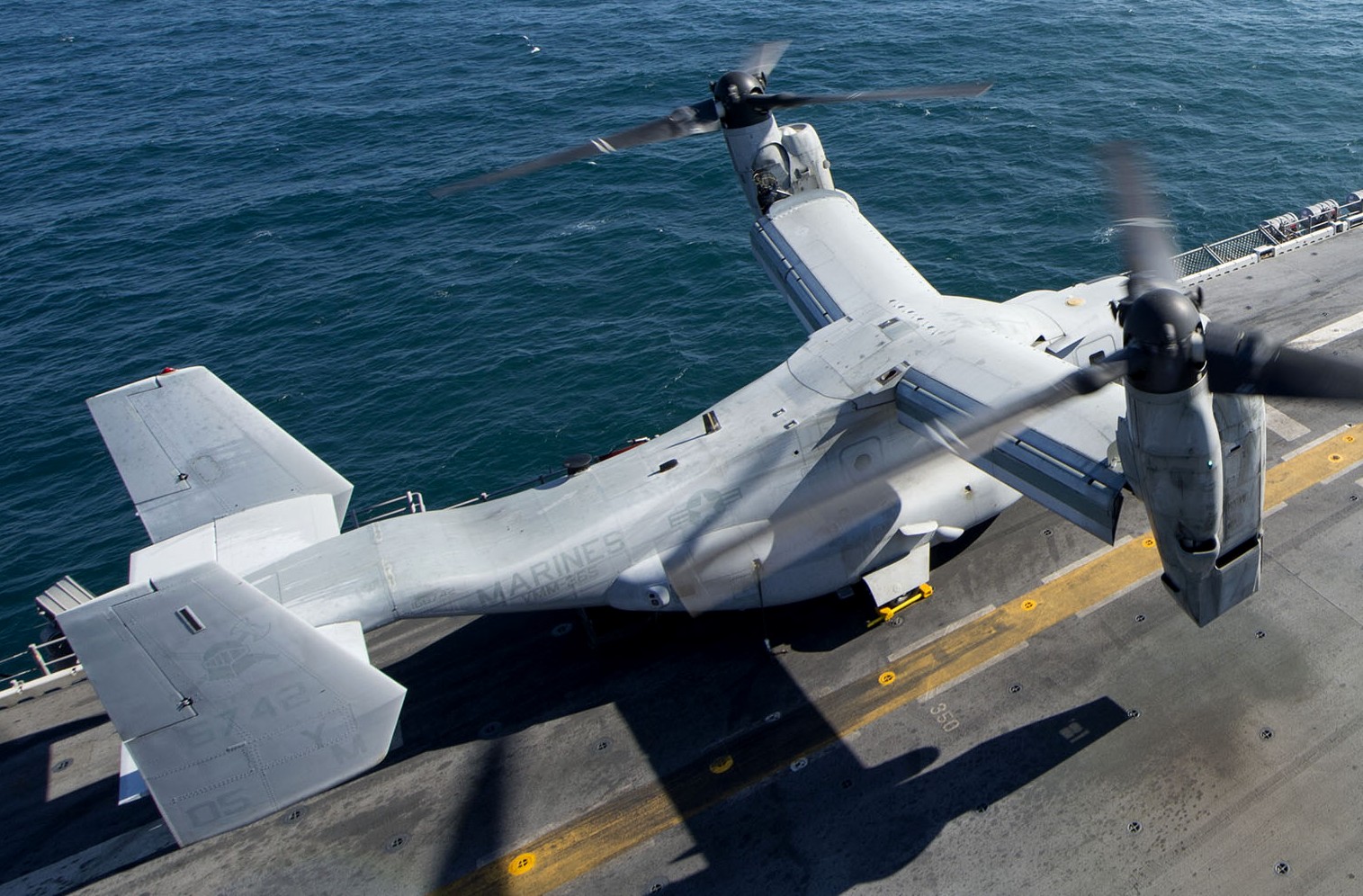 MV-22B Osprey (VMM-365) aboard USS Iwo Jima (LHD 7) - October 2014  MV-22B Osprey (VMM-365) aboard USS Fort McHenry (LSD 43) - October 2014  MV-22B Osprey (VMM-365) aboard USS Iwo Jima (LHD 7) - September 2014 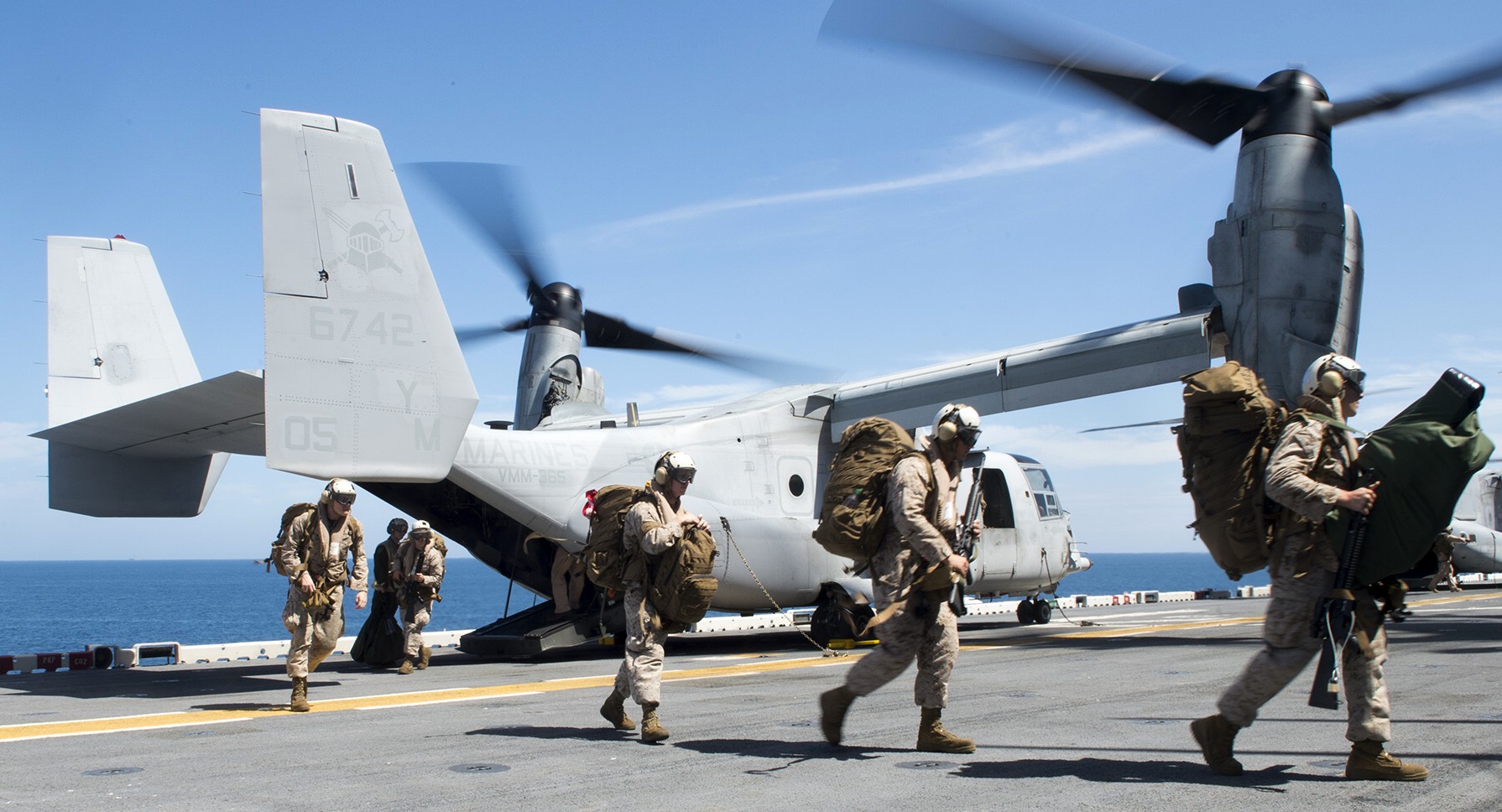 MV-22B Osprey (VMM-365) aboard USS Iwo Jima (LHD 7) - September 2014  MV-22B Osprey (VMM-365) aboard USS Iwo Jima (LHD 7) - August 2014  MV-22B Osprey (VMM-365) aboard USS New York (LPD 21) - November 2013  MV-22B Osprey (VMM-365) over MCAS New River, North Carolina - February 2013  MV-22B Osprey (VMM-365) over MCAS New River, North Carolina - February 2013  MV-22B Osprey (VMM-365) over MCAS New River, North Carolina - February 2013  MV-22B Osprey (VMM-365) over MCAS New River, North Carolina - February 2013 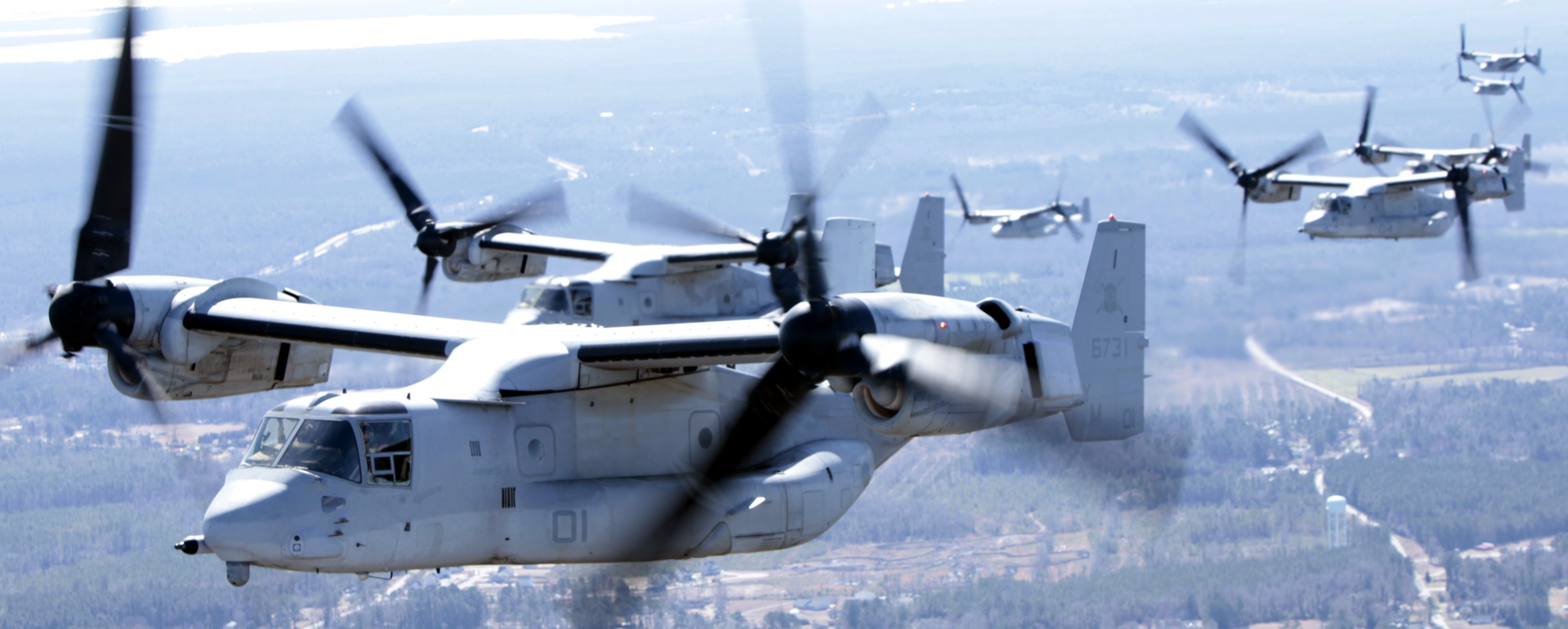 MV-22B Osprey (VMM-365) over MCAS New River, North Carolina - February 2013  MV-22B Osprey (VMM-365) over MCAS New River, North Carolina - February 2013 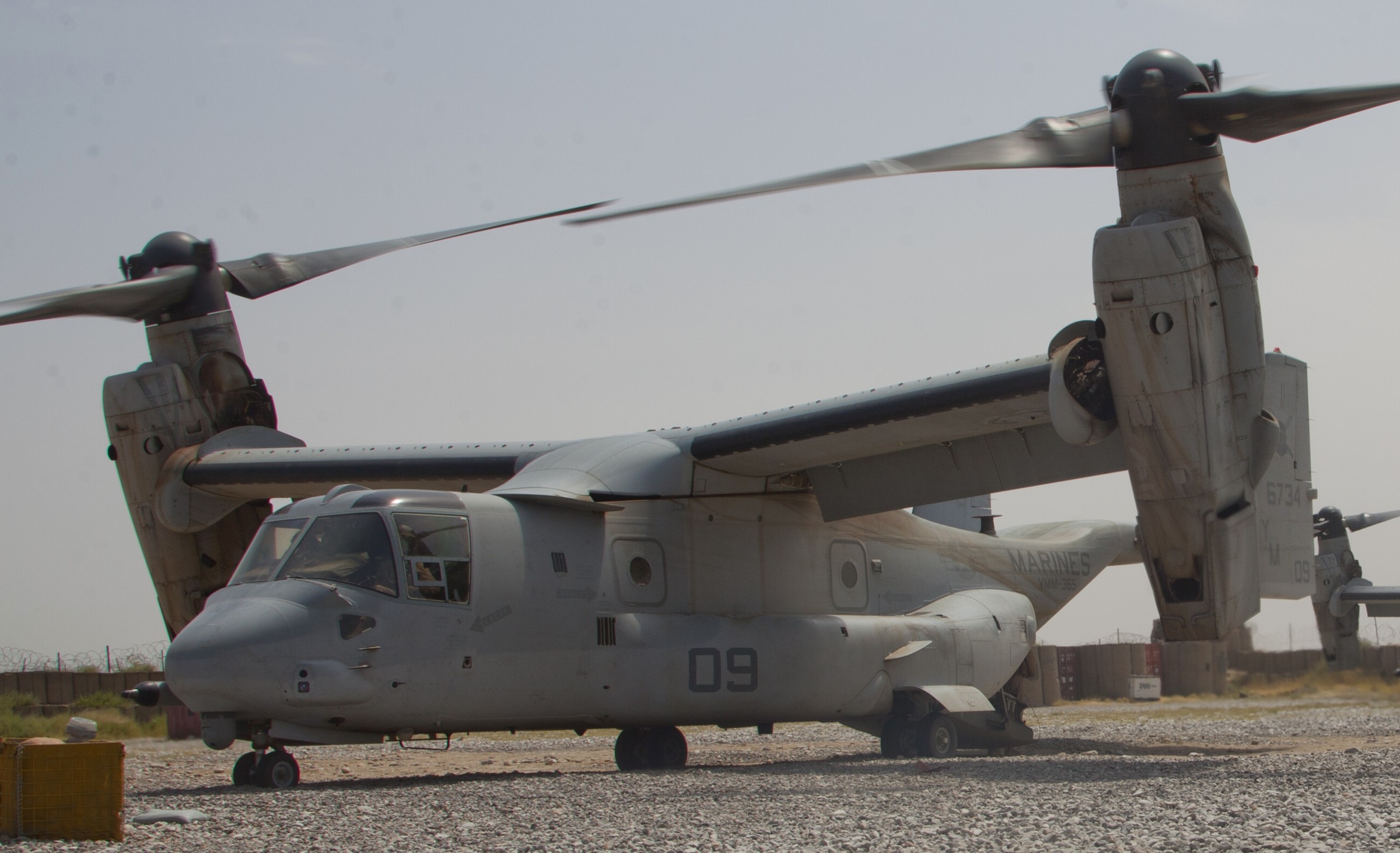 MV-22B Osprey (VMM-365) - Afghanistan - July 2012 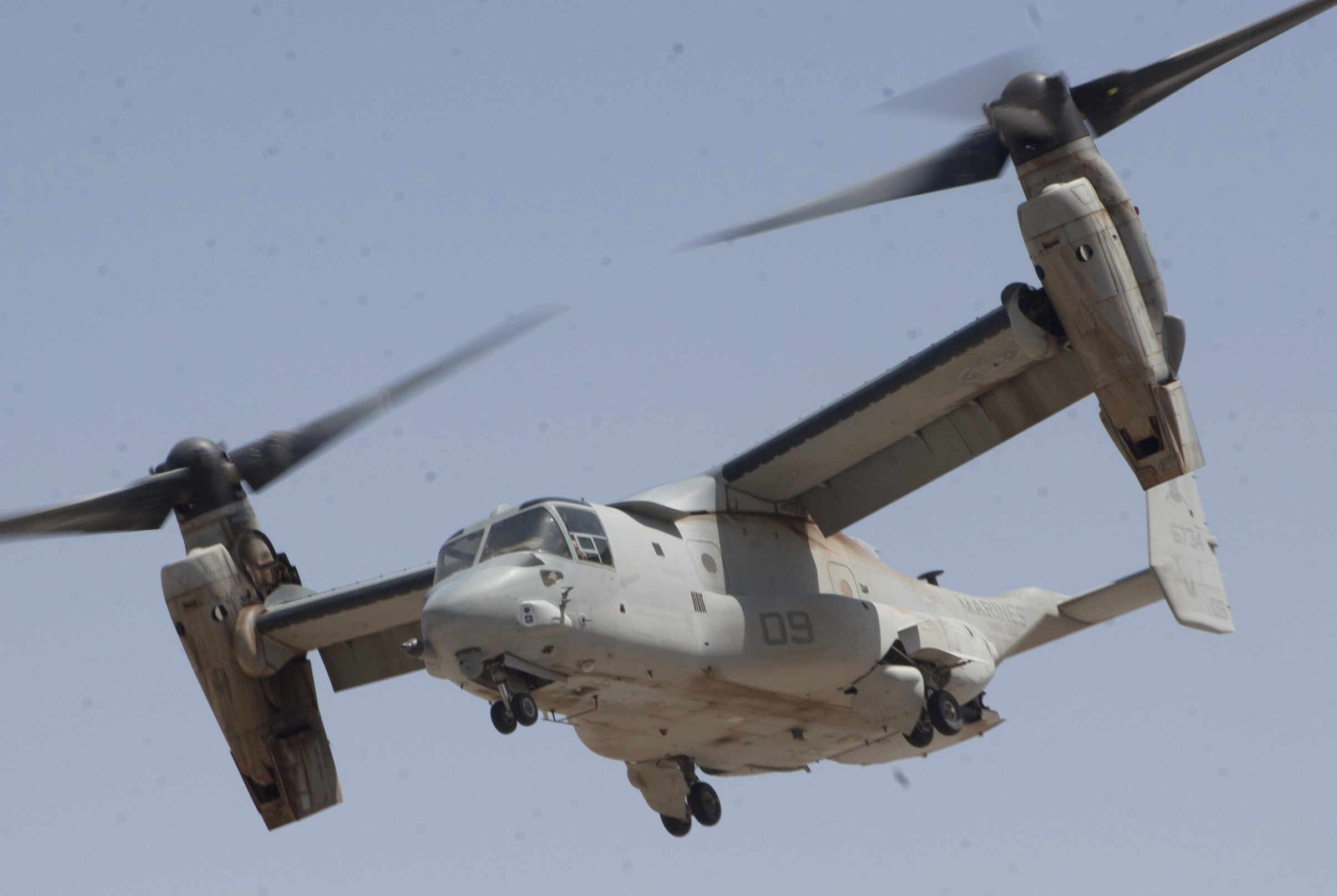 MV-22B Osprey (VMM-365) - Afghanistan - July 2012  MV-22B Osprey (VMM-365) - Afghanistan - July 2012  MV-22B Osprey (VMM-365) - Afghanistan - May 2012  MV-22B Osprey (VMM-365) - Afghanistan - May 2012  MV-22B Osprey (VMM-365) - Afghanistan - May 2012  MV-22B Osprey (VMM-365) - Afghanistan - May 2012  MV-22B Osprey (VMM-365) - Afghanistan - April 2012  MV-22B Osprey (VMM-365) - Afghanistan - April 2012  MV-22B Osprey (VMM-365) - Afghanistan - April 2012  MV-22B Osprey (VMM-365) - Afghanistan - March 2012  MV-22B Osprey (VMM-365) - Afghanistan - March 2012  MV-22B Osprey (VMM-365) - Afghanistan - March 2012  MV-22B Osprey (VMM-365) - Afghanistan - March 2012  MV-22B Osprey (VMM-365) - Afghanistan - March 2012  MV-22B Osprey (VMM-365) at MCAS New River, North Carolina - December 2011  MV-22B Osprey (VMM-365) - Belize - September 2011  MV-22B Osprey (VMM-365) - Belize - September 2011  MV-22B Osprey (VMM-365) - Afghanistan - September 2010  MV-22B Osprey (VMM-365) - Afghanistan - September 2010  MV-22B Osprey (VMM-365) - Afghanistan - September 2010  VMM-365 - July 2010 |
|||||||
|
|
|||||||
|
Marine Medium Helicopter Squadron 365 was established on 1 July 1963
at Marine Corps Air Facility (MCAF) Santa Ana, California, and was
assigned to Marine Aircraft Group (MAG) 36, 3d Marine Aircraft Wing
(MAW). Flying UH-34Ds, the squadron’s mission was to provide assault
transport of troops and cargo of Fleet Marine Forces during
ship-to-shore movements. After participating in squadron training
and several exercises, HMM-365 was reassigned to MAG-16, 1st MAW at
MCAF Futenma, Okinawa on 29 August 1964 in preparation for the
squadron’s deployment to Da Nang, Republic of Vietnam. The squadron
redeployed on 7 October 1964 to Da Nang and immediately began
performing resupply missions as the last of HMM-162’s personnel were
leaving the country. Commanding Officer (CO) Lieutenant Colonel Joseph Koler’s crew airlifted over 25,000 pounds of cargo to various outposts around Da Nang the first day. On 11 October the newly arrived Marine pilots and aircrews tasted their first actual firefight when 8 UH-34Ds drew Viet Cong fire while landing a 112 man Vietnamese unit in the hills 10 miles west-southwest of Tam Ky. On October 26 the Blue Knights suffered their first combat casualties when a copilot and crew chief were wounded by Viet Cong small arms fire while the helicopter was approaching a poorly protected landing zone 10 miles southwest of Tam Ky. The pilot was able to miraculously return the damaged aircraft to Tam Ky and land safely, whereupon the seriously wounded were evacuated to Nha Trang and the crew chief was administered first aid. In early November, at the height of the monsoon season, Typhoon Iris struck the Annamese Coast. The tropical storm was followed by nearly a week of continuous rain, wind, and fog. The hazardous weather conditions caused flight operations to be suspended except for emergency medical evacuations. When flight operations resumed on November 10th, the Marine Corps Birthday, the Leatherneck crews concentrated on rescuing Vietnamese civilians from the inundated coastal plains. Between 1700 and 1900 on their first day of flood relief operations and after a ‘late night of birthday celebrating’, Lieutenant Colonel Koler’s Marines rescued 144 flood victims. At the end of a 72-hour time period, the Blue Knights had successfully rescued over 1,500 flood victims all the while under hostile guerrilla fire. On 19 November two UH-34Ds flew in support of a Tiger Flight mission conducted just south of the Song Thu Bon about 17 miles from Da Nang. The armed UH-34Ds expended 90 rockets and 500 rounds of 7.62mm ammunition on enemy positions during pre-landing strikes. The squadron executed similar operations the following day and a total of 15 Enemy Killed in Action (EKIA) for the 48 hour period was confirmed. Multiple Tiger Force operations ensued with the squadron’s newfound ability to not only put troops in the zone but also provide fire suppression for the infantry units once on the ground during initial phases of assault operations. The squadron remained at Da Nang until 17 February 1965. The squadron embarked aboard the USS PRINCETON on 7 March 1965 to support the 7th Fleet’s Special Landing Force until 27 April. HMM-365 returned to Da Nang on 15 May and remained until relieved in August 1965. Nicknamed “Koler’s Klowns” after their beloved CO, they flew over 12,000 mishap-free hours in support of combat operations and received the newly developed naval aviation safety award. All told, during HMM-365’s ten month tenure, the Blue Knights received 1,180 Air Medals, 8 Purple Hearts, 17 Distinguished Flying Crosses, and 1 Legion of Merit for their heroic deeds. On 1 September, HMM-365 was reassigned to MAG-26 MCAF New River, North Carolina. For its service in Vietnam, the “Magnificent Flying Circus” was awarded the Presidential Unit Citation (PUC) and the Navy Unit Commendation (NUC). During the latter part of 1965 and the first half of 1966, HMM-365 focused on rebuilding the squadron while supporting 2nd Marine Division units. On 13 September 1966, the squadron embarked aboard the USS Boxer to participate in CARIB 3-66, MEBLEX 1-66, and LANTFLEX-66. Also during this period, the squadron conducted relief operations in the Dominican Republic and Haiti following Hurricane Inez. HMM-365 returned to New River on 15 December 1966. HMM-365 received its first CH-46D on 28 March 1967 and had finished the transition by late June. Later in 1967 the squadron received the Chief of Naval Operations “Readiness Through Safety” Award and the Commanding General, 2d MAW Outstanding Achievement Trophy. During November 1967, the squadron prepared for another Caribbean deployment. On 12 January 1968, HMM-365 departed to participate in CARIB 3-67 and returned to New River on 22 March. On 13 February 1969, HMM-365 embarked aboard the USS Guam for deployment to the Caribbean and participation in CARIB 1-69. The squadron took part in Operation VERITAS II, ESCORT TIGER V, and EXOTIC DANCER II before returning to New River on 30 June. HMM-365 was again recognized for its safety record when it was presented with the Chief of Naval Operations (CNO) Aviation Safety Award on 20 November. In January 1970, the squadron received eight new CH-46F aircraft in preparation for its upcoming deployment to the Caribbean in support of CARIB 2-70. On 30 March, the squadron went composite with the addition of four CH-53Ds and two UH-1Es. HMM-365(REIN) embarked aboard the USS Guam on 13 May and participated in Exotic Dancer III later that month. In June, the squadron flew disaster relief operations in Peru following an earthquake. On 1 March 1971, HMM-365 was deactivated after having surpassed 50,000 mishap-free flight hours. Other awards that the squadron had received during its first eight years included the Meritorious Unit Commendation (MUC), the National Defense Service Streamer, the Vietnam Service Streamer, and the Vietnam Cross of Gallantry with Palm. HMM-365 was reactivated on 13 June 1980, and was again assigned to MAG-26. The “Blue Knights” were now equipped with the CH-46E. During the next several years, the squadron regularly supported operations at MAWTS-1 in MCAS Yuma, Arizona, Combined Arms Exercises in Twentynine Palms, California, amphibious operations in the Caribbean, mountain warfare training at Camp Merrill, Mosby, Georgia, and cold weather exercises in northern Norway. For superior performance during NATO Exercise COLD WINTER ’83, Commanding General, Marine Corps Forces Atlantic awarded the squadron with its second MUC. On 20 May 1983, HMM-365 was reassigned to MAG-29. HMM-365 continued its support of various exercises by participating in SACEX 83 aboard the USS Nassau, mountain warfare training at Camp Merrill, and Ocean Venture 84 aboard the USS Iwo Jima. While participating in Ocean Venture 84, the Blue Knights surpassed 70,000 mishap-free flight hours. The next year during a cross-country flight to support CAX and WTI, HMM-365 became the first tactical helicopter squadron to achieve 75,000 mishap-free flight hours. In 1986, The Blue Knights flew in support of Alpine Warrior 1-86 and spent the remainder of the year flying in support of 2nd Marine Division and 2nd MAW. On 2 December 1986 the squadron reached 80,000 mishap-free flight hours. In 1987 the Blue Knights embarked aboard the USS Guam for Solid Shield-87 and then began to focus on preparing for HMM-365’s first Landing Force Sixth Fleet (LF6F) deployment. The squadron went composite on 1 September 1987 and after workups, departed as the Air Combat Element (ACE) for the 26th Marine Amphibious Unit on 1 March 1988. During the deployment, the Blue Knights participated in Spanish PHIBLEX, Italian PHIBLEX, NATO Exercise DRAGON HAMMER 88 and other smaller training exercises in Italy, France, and Israel. HMM-365 returned to New River on 28 August, having surpassed 90,000 mishap-free flight hours during the deployment. On 12 April 1989, HMM-365 went composite for its second LF6F deployment as the ACE for the 24th Marine Expeditionary Unit (MEU). After successful workups, the 24th MEU Special Operations Capable (SOC) departed on 12 October 1989. The squadron participated in Spanish PHIBLEX in November and had reached 97,400 mishap-free flight hours before an AH-1T was lost at sea. The Blue Knights continued to press with the Tunisian PHIBLEX in December, and training exercises in Italy, France, Israel, and Gibraltar the following year. The squadron returned to New River on 9 April 1990. Four months later after the Iraqi invasion of Kuwait, HMM-365 embarked aboard the USS Guam on 19 August 1990 for Operation DESERT SHIELD. After arriving in the North Arabian Sea on 15 September, the Blue Knights in concert with HMM-263 supported Exercises SEA SOLDIER I and II, IMMINENT THUNDER, and SEA SOLDIER III through the remainder of the year. On 6 January 1991, HMM-365 and HMM-263 conducted Operation EASTERN EXIT, the Non-Combatant Evacuation (NEO) of the American Embassy in Mogadishu, Somalia. The NEO was successful with 281 American and foreign nationals being evacuated. After returning to the Gulf, the squadron supported Exercise SEA SOLDIER IV from 26 January to 2 February. Operation DESERT STORM began on 17 February and the Blue Knights conducted Night Vision Goggle (NVG) long range assault support in support of the amphibious demonstration against Bubiyan Island on 26 February. A cease-fire went into effect on 28 February, and the Blue Knights returned to MCAS New River on 18 April 1991. For the remainder of the year, HMM-365 supported CAPEX, UNITAS XXXIII, CAX, various air shows, and Gulf War victory celebrations. On 26 July, the squadron was awarded the 1990 CNO Safety Award and the Fleet Marine Forces Atlantic (FMFLANT) Annual Aviation Safety Award. The Blue Knights were also awarded the NUC (Second Award) and the Southwest Asia Streamer with two bronze stars for the squadron’s participation in Operations DESERT SHIELD and DESERT STORM. HMM-365 went composite on 10 January 1992 in preparation for its upcoming LF6F 2-92 deployment. After successful workups during TCAT 2-92 and TRUEX XVI, the squadron embarked aboard the USS Iwo Jima and departed on 28 May. After completing training exercises in Spain and Italy, the ARG moved into the Adriatic Sea to support Operation PROVIDE PROMISE. While on station in the Adriatic, the squadron embarked four aircraft aboard the USS Trenton to participate in exercises in Israel, Tunisia, and France. On 3 September, while on station near the Yugoslavia coast, the Blue Knights launched a TRAP mission into Yugoslavia following the downing of an Italian cargo aircraft carrying relief supplies into Sarajevo. The squadron rejoined off the coast of Turkey to participate in Display Determination 92. HMM-365 then spent the remainder of the deployment on station in the Adriatic before returning to New River on 24 November 1992. On 26 April 1993, the Blue Knights embarked aboard the USS Guadalcanal to participate in Ocean Venture 93 off the coast of Viegues Island, Puerto Rico. After returning to New River, the squadron was awarded the FMFLANT Aviation Safety Award on 14 June and the 1992 CNO Aviation Safety Award on 3 August. On 21 November, the Blue Knights went composite for their upcoming deployment as the ACE for the 26th MEU; the squadron departed for LF6F 2-94 on 21 May 1994. The MEU’s first stops were Southampton, England and Cherbourg, France for the D-Day 50th Anniversary Commemorations. The squadron was then diverted to the coast of Somalia for NEO contingencies in Mogadishu, Somalia. During the remainder of the deployment, the Blue Knights participated in several exercises including African Rifle in Kenya, Tunisian PHIBLEX, BETACOM 94 in Spain, and Dynamic Guard 94 in Turkey. The squadron also provided support for the Presidential visit to the Israel-Jordan Peace Accords and surpassed 25,000 mishap-free flight hours before returning to New River on 16 November 1994. On 27 June, the squadron embarked a detachment aboard the USS Ashland for UNITAS XXXVI. After returning to New River, the Blue Knights deployed in order to support CAX 9/10 and WTI. On 23 September 1995, the squadron was presented with the 1995 Marine Corps Aviation Association (MCAA) Edward C. Dyer Marine Medium Helicopter Squadron of the Year Award. On 4 May 1996, the Blue Knights embarked aboard the USS Nassau to participate in Joint/Combined Exercise PURPLE STAR. After returning, HMM-365 again went composite as the ACE for the 26th MEU. The squadron departed for its LF6F 1-97 deployment aboard the USS Nassau on 23 November 1996. During the deployment, the Blue Knights supported Operation DECISIVE ENDEAVOR in Bosnia-Herzegovina, participated in PHIBLEX and Exercise DESTINED GLORY in Spain, and in INVITEX and Exercise ISLAND THUNDER in Italy, and later supported Operation SILVER WAKE, the Non-combatant Evacuation of the American Embassy in Tirana, Albania. The squadron successfully evacuated 851 American and third country nationals while surpassing 38,000 mishap-free flight hours. The Blue Knights returned to New River on 22 May 1997. In September 1997, the squadron received the 1997 MCAA Edward C. Dyer Marine Medium Helicopter Squadron of the Year Award. To close out the year, the Blue Knights achieved 40,000 mishap-free flight hours and the squadron was awarded the CNO Safety Award. In July 1998, the Blue Knights deployed a detachment to Roosevelt Rhodes, Puerto Rico to participate in UNITAS while the remainder of the squadron supported Operation URBAN WARRIOR at Camp Lejeune. On 6 October, HMM-365 conducted the first Chemical Biological Incident Response Force (CBIRF) exercise in conjunction with a II MEF NBC inspection. The squadron continued workups until departing with the 26th MEU on 15 April 1999. The Blue Knights supported Operations NOBLE ANVIL and SHINING HOPE in the Kosovo/Serbian Conflict and land-based aircraft at Skopje, Macedonia from June to July to support NATO’s peacekeeping and humanitarian assistance missions. In September the 26th MEU was ordered to support earthquake relief operations in Turkey. HMM-365 flew rescue team and surveyor lift missions during Operation AVID RESPONSE and returned to MCAS New River in October 1999. In late April 2000, a squadron detachment chopped to HML/A-269 to form the ACE for Special Purpose Marine Air-Ground Task Force (SPMAGTF-8) which would support Operation EASTERN ACCESS on Vieques Island. SPMAGTF-8 embarked aboard the USS Bataan on 28 April and supported the removal of protestors from Vieques Island ranges until its return on 17 May. On 19 March, the Blue Knights composited in preparation for the upcoming LF6F 1-02 deployment. Following the terrorist attacks on September 11th, the Blue Knights prepared for immediate departure. The 26th MEU deployed on 20 September. After participating in Exercise BRIGHT STAR in Egypt, the MEU transited to a position off the coast of Pakistan to begin combat operations in support of Operation ENDURING FREEDOM. HMM-365(REIN), in concert with HMM-163(REIN), launched 6 CH-53Es to secure FOB Rhino, nearly 800 nautical miles inland. After securing Camp Rhino and Kandahar Airport in Afghanistan, the Blue Knights supported coalition forces raids against the Taliban from December 2001 to February 2002. The 26th MEU successfully retrograded to the USS Bataan by the end of February 2002. In March, the MEU transited to the Red Sea for a potential NEO in Yemen to support the Vice President’s visit to the region. On 19 April 2002, the Blue Knights returned to New River. In January 2003, the Blue Knights prepared for deployment to Ali Al Salem Airbase, Kuwait in support of Operation IRAQI FREEDOM. Squadron aircraft were embarked aboard fast support shipping (FSS) for the trip to Kuwait in late January, the first time such a process had been attempted under 2d MAW. Squadron personnel arrived in Kuwait on 5 February and after re-assembling aircraft later in the month, the Blue Knights prepared for combat operations. Operation IRAQI FREEDOM began on 20 March with HMM-365 leading the TRAP Team effort for the initial heliborne raids on the crucial Al Faw Peninsula. From 20 March until 1 May, the squadron provided CASEVAC and assault support to I MEF, the 24th MEU, the 15th MEU, Task Force Tarawa, and United Nations forces. Blue Knight crews flew multiple hasty raids and recon inserts as ground forces progressed further north towards Baghdad. The squadron supported I MEF operations from Ali Al Salem until mid-April when it re-deployed itself in one day to Jalibah Forward Operating Base (FOB), Iraq where it met up with MAG-29. The squadron conducted flight operations from Iraq until 10 May when the squadron embarked aboard the USS Kearsarge. After supporting the President’s visit to Egypt and Jordan, the USS Kearsarge transited to Liberia for possible NEO operations. The Blue Knights returned to New River on 28 June 2003. On 7 Aug 2004 HMM-365’s main body departed New River, NC for Al Asad Air Base, Iraq. On 21 August the squadron assumed the assault support mission from HMM-261. On New Year’s Eve they executed a leaflet drop over the town of Haditha in support of the 31st MEU PSYOPS, a flight that carried the Iraqi Land Forces Commander, LtGen Abdul Qater to Baghdad, and a flight that lifted pallets of toys on a humanitarian mission from LZ Washington to FOB Duke. On 12 Jan 2005 the Blue Knights executed a 4 plane division raid in support of 1/8, Bravo Company, 2nd Platoon(+). The mission consisted of a 40-man insert just prior to sunrise north east of Al Kharma in order to capture family members of Oskar Habbas, believed to be responsible for the kidnapping of Nicholas Berg. On 27 January HMM-365 inserted members of 2d Recon Battalion into the Zaidon region to set up a hasty vehicle check point. The mission resulted in the capture of insurgents that had repeatedly called in deadly indirect mortar fires on 2d Recon headquarters. On 28 January 2005 the eve of one of the most significant international political events in the history of Iraq the Blue Knights launched 3 sections of CH-46Es to transport interpreters and polling station volunteers for the upcoming Iraqi national elections, which were a resounding success. On February 28, 2005 HMM-365 returned to MCAS New River after flying more than 3,961 combat hours, 2,404 sorties, 11,162 passengers, and 748,496 pounds of cargo. On August 29, 2005 Hurricane Katrina devastated the Gulf Coast. On September 2, 2005 HMM-365 aircraft begin rescue and evacuation operations along the Gulf Coast as part of HMH-464(REIN). The HMM-365 detachment rescued over 170 citizens. On 30 September 2005, HMM-365 detachment returned to MCAS New River. On 30 November 2005 HMM-365 was designated the Air Combat Element(ACE) for the 24th MEU and embarked on the USS IWO JIMA on 07 June 2006. From July 6-18, 2006 the squadron participated in Exercise INFINITE MOONLIGHT from King Faisal Air Base, Jordan. On 15 July 2006, while the squadron was conducting operations in Jordan, the 24th MEU received a Fragmentary Order (FRAGO) to prepare for the evacuation of American citizens from the city of Beirut, Lebanon in response to the rapid deterioration of relations between Israel and Lebanese Hezbollah in the southern region of the country of Lebanon. On 17 July, the ACE began the NEO as two CH-53Es launched from Royal Air Field (RAF) Akrotiri and landed at the helipad of the American Embassy of Beirut, inserted Forward Command Element (FCE) personnel and extracted American citizens to the island of Cypress. At the conclusion of operations in Lebanon, HMM-365(REIN) CH-46Es and CH-53Es had flown a total of 431.8 flight hours, safely air-lifting 2,020 American citizens from the American Embassy to Expeditionary Support Group (ESG) shipping and the island of Cypress. In addition, squadron assault aircraft carried 304,930 lbs of cargo to and from the embassy, including palletized food and water, which aided the Marines and American citizens in the embassy. In June 2007 the squadron, now under Lieutenant Colonel John C. Vara, prepared to once again act as the ACE for the 24th MEU. During the work-ups for deployment the squadron performed MEU support and squadron training while operating from Blackstone Army Airfield at Fort Pickett, Virginia. At sea periods were conducted aboard the USS Nassau. At the tail end of the pre- deployment training plan the mission for the 24th MEU and HMM-365 would change dramatically. The MEU would disembark Expeditionary Strike Group shipping and begin sending assets to Kandahar Airfield, Afghanistan. Within a month of arrival in theatre the squadron began flight operations at Kandahar practicing day and night desert landings in preparation for Operation AZADA WOZA. In May 2008 HMM-365 REIN completed a battalion minus insert to a desert zone under low light level conditions in the Garmsir district, a known enemy stronghold. The squadron continued to support Battalion Landing Team (BLT) 1/6 for its historic fight for control of the Taliban stronghold of Garmsir. During the operation, the Blue Knights were conducting a variety of missions from three different locations to ensure 24 hour casualty evacuation, close air support, assault support, and aerial reconnaissance. Upon return from Afghanistan the squadron changed command from Lieutenant Colonel John C. Vara to Lieutenant Colonel Richard F. Fuerst. During a re-designation ceremony aboard MCAS New River on January 15, 2009 the squadron changed from helicopters to tilt rotor MV-22 aircraft marking the end of the CH-46E era of the Blue Knights and simultaneously ushering in the MV-22 era. Along with the transfer of their aircraft, less than a quarter of the squadron’s personnel remained. With another combat deployment on the horizon under 3rd MAW (Forward), VMM-365 began the arduous task of preparing for combat operations once again. In April 2009 the Blue Knights received their first MV-22. Most Marines had only minimal experience on the Osprey when they received notice that they would deploy to Afghanistan in June 2010. Although transitioning squadrons had previously received more time to train, operational commitments reduced the timeframe significantly for the Blue Knights. In June 2009, the squadron began in-house flight training with only six aircraft commanders and less than half of its Ospreys. By November 2009, VMM-365 had received its full complement of aircraft and personnel. During this time, the squadron completed all of the required inspections including the 2d MAW Logistics Management Assistance and Training (LOGMAT) inspection and the 2d MAW Commanding General’s Readiness Inspection (CGRI), receiving the highest scores of any squadron within 2d MAW. The Blue Knights continued to train at MCAS New River until January 2010, when the squadron deployed to Yuma, Arizona, for their pre-deployment training. There, the squadron conducted operations in the desert environment, concentrating on core-skill training flights that would prepare its pilots and aircrew for Afghanistan. After completing their training in Yuma, VMM-365 moved to Twentynine Palms, California, to participate in the Enhanced Mohave Viper (EMV) 3-10 training exercise. After completing EMV in March, VMM-365 became the first Osprey squadron to be combat-capable in less than 15 months. Immediately, the Blue Knights redeployed to MCAS New River, North Carolina, to await their deployment orders for Afghanistan. Finally, in June 2010, VMM-365 embarked on commercial and military air transportation and reported to 3d MAW (FWD), conducting a Transfer of Authority (TOA) with the “Raging Bulls” of VMM-261 at Camp Bastion, Helmand Province, Afghanistan, on 7 July 2010. The Blue Knights’ Ospreys became part of a team of several platforms providing assault support for Task Force (TF) Leatherneck and coalition forces. VMM-365 left their V-22s at MCAS New River, falling on equipment and aircraft already in Afghanistan with VMM-261. Eight months of combat operations in the desert environment had taken its toll on the aircraft; the Blue Knights began their next task of preparing the Ospreys for an additional seven months in combat. Simultaneously, the Blue Knights began flying missions, and the Marines of VMM-365 transitioned from confident new tiltrotor pilots and enlisted aircrew into experienced combat crews. Even with temperatures above 115°F and density altitudes exceeding 7,000 feet, the Osprey’s capabilities were impressive as it supported the International Security Assistance Force (ISAF). Each month in Afghanistan, the Blue Knights broke their previous month’s flight time record, and in November posted a record mission capable rate of 72.7% while flying over 450 hours. The Blue Knights launched several sections each day executing general support (GS) missions ranging all corners of the RC (SW) battle space. In addition to GS missions which were vital in supporting the ground forces, the squadron supported over a dozen named operations. Those operations consisted of traditional medium-lift inserts under low light level conditions, aerial delivery operations to re-supply troops on the ground and longer-range missions to the borders of Afghanistan. In addition to lifting U.S. Marines, the Blue Knights transported U.K. troops, Georgian Troops, Afghan National Army, Afghan National Police, and key Afghan civilians as part of an international coalition to support the fight against the Taliban. By the end of the year the squadron, commanded by Lieutenant Colonel Craig C. LeFlore, had logged 2027.8 combat flight hours, safely transporting 22,395 passengers and 1,073,469 pounds of cargo. They returned home to MCAS New River in January 2011 after their successful first deployment as a tiltrotor squadron. In January 2012, only eleven months after returning from a successful deployment to Afghanistan, VMM-365 returned to Camp Bastion to conduct combat operations in support of Operation Enduring Freedom. During the month of April, the squadron conducted 35 Named Operations and increased that number to 39 in May and 42 in June. VMM-365 flew in support of 193 Named Operations over the course of the seven-month deployment. By comparison, the squadron conducted just 10 Named Operations during OEF 10.2. In addition to successfully supporting an average of one Named Operation per day, the squadron moved 36,047 passengers and 769,102 pounds of cargo across the battle space while conducting General Support missions. The squadron expanded the accepted capabilities of the MV-22 by operating across the spectrum of Assault Support and displaying wide-ranging and flexible skill sets. Centering on the primary mission of a VMM, the Blue Knights conducted conventional insertion/extraction operations, narcotic raids, Aerial Reaction Forces, and Aerial Interdiction. On 25 March 2012, a flight of six Blue Knight Ospreys conducted the largest tiltrotor-borne insert in history by inserting 594 coalition personnel in support of Operation JAWS. VMM-365 also launched flights of three or more aircraft on 48 different occasions, to include 17 flights of five or more aircraft. Conducting long-range Casualty Evacuation missions within the critical “Golden Hour,” leaflet drops in support of psychological operations, battlefield illumination missions for other MV-22s, and developing & operating as a Command and Control platform during three battalion-level operations are examples of some of the wide-ranging and innovative operations the Blue Knights successfully executed. The maintenance department’s Emergency Reclamation Team was tested on several occasions; to include, 27 June 2012 when two separate aircraft received significant battle damage after inserting 1st Reconnaissance Battalion Marines to a tactical landing zone. One of these aircraft was forced to make an emergency landing to a nearby FOB after taking 12 enemy medium machine gun rounds. Less than 18 hours later, VMM-365 fixed the damaged aircraft and flew safely back to Camp Bastion. Throughout the deployment, the Blue Knights were engaged by enemy fire 26 times, returned fire 12 times, and sustained battle damage to five aircraft. Six of the squadron's MV-22Bs self-deployed to Morón Air Base on 27 April 2013, as part of the Special Purpose Marine Air Ground Task Force - Crisis Response. On May 27, 2014 VMM-365 went composite with HMLA-269, HMH-461, MWSS-272, MACG-28, MALS-26 and MALS-29 and was redesignated VMM-365(REIN) in support of 24th Marine Expeditionary Unit. Three months later, VMA-231 and MALS-14 joined the ACE resulting in more than 500 Marines and sailors attached to VMM-365(REIN). Of the 29 aircraft assigned, the ACE can employ (12) MV-22B, (4) CH-53E, (4) AH-1W, (3) UH-1Y, and (6) AV-8B. Additionally the ACE can employ multiple Low Altitude Air Defense teams and aircraft controllers. On December 12, 2014 VMM-365(REIN) deployed with 24 MEU, Amphibious Squadron 8 and the USS Iwo Jima Amphibous Readiness Group. On July 16, 2015 VMM-365(REIN) returned from deployment with 24th Marine Expeditionary Unit. The Blue Knights expertly stood the alert, ready to respond. The ACE supported multiple bilateral exercises in 6th and 5th Fleet areas of responsibility, conducted combat missions in Iraq in support of Operation INHERENT RESOLVE, assisted with the evacuation of US Embassies in Yemen in both San'na and Aden, supported multiple US Ambassador visits to Aden, Yemen, and served as an airborne deterrence force against surface ships delivering lethal weapons to Huthi rebels in Yemen. In the seven month deployment, the squadron flew more than 3,500 hours and maintained the highest overall aircraft readiness rate of any Aviation Combat Element since deploying with the MV-22B Osprey. source: VMM-365 website & wikipedia |
|||||||
|
|
|||||||
|
|
|||||||
|
patches & more |
|||||||
 |
|||||||
|
|
|||||||
| | seaforces.org | US Marine Corps Air units start page | | |||||||
